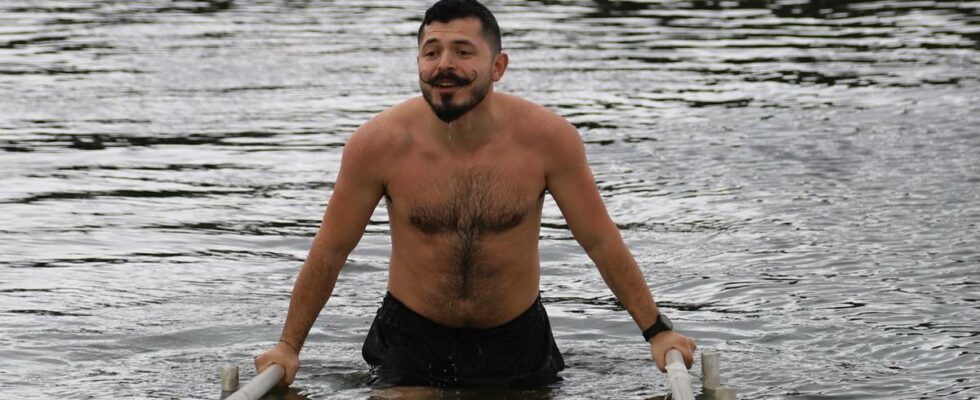– It is perhaps one of the most important choices I have made. For many, this is not a choice you need to make. It almost happens by itself. But Julian Osorio had to actively choose to learn to swim. He was then 30 years old. – There is always a shame associated with it. It is a shame that you cannot participate on an equal basis with others. You kind of have to try to hide it a little when you’re with friends who are bathing. And it was precisely on a trip with friends in Arendal that he made up his mind. His fiancee and some friends were swimming and enjoying themselves in potholes. Julian, as usual, sat on the side and watched. But this time it was too much. In the car on the way back from the potholes, he signed up for adult swimming training at Sandnes Swimming and Lifesaving Club. Now the relationship with water is completely different. – It was important for my personal safety. It is something that gives me security. Osorio is a politician, and sits on the municipal council in Sandnes for Venstre. He himself has been involved in adopting a pilot project to strengthen children’s swimming skills, featured in Stavanger Aftenblad (external link). The school in the USA did not have swimming training like in Norway, explains Julian Osorio. Photo: Adrian Fosse Årthun / news Poorer at swimming In 2021, a survey (external link) was conducted among the country’s 10-year-olds, commissioned by the Norwegian Swimming Association and the Rescue Company. There it emerged that pupils with an immigrant background (non-European countries) are worse at swimming, and more dependent on receiving instruction through school or swimming courses. In addition, this group was over-represented among those who could only swim a few strokes, and under-represented in having taken swimming marks. For Osorio, there were natural reasons why he never learned to swim as a child. Being able to swim was not the most important thing – We moved around a lot growing up. Mum was very much at work. She had to prioritize creating financial security for us. Osorio’s parents are from Colombia. He himself was born in Norway, but moved to the USA with his family at an early age. Growing up, he had few encounters with water. If they wanted to swim, they would have had to drive for several hours to find a suitable place. Learning to swim became both difficult and de-prioritised. His parents were also never very good swimmers. He explains that in Colombia it is preferably those with the most money who take the time for such things. – It was not the most important thing for those who did not have as much money. – There are also many people who do not have access to necessary facilities or natural water sources, depending on whether they live in the countryside or close to town, he adds. Not getting the same training – We see in every survey, which has been carried out since 2003, that pupils with parents born outside Europe have poorer swimming skills than those with parents born in Norway or Europe. That’s what Tanja Krangnes, who is specialist manager for drowning prevention at the Rescue Company, says. Tanja Krangnes works with drowning prevention at Redningsselskapet. Photo: The rescue company – Maybe it’s because they come from countries that don’t have the same culture for swimming, beach life and boating. Many Norwegians have been used to traveling on, in and near water ever since we were little. In addition to this, there are more people who come to Norway at secondary school age, or who are older than that. They do not necessarily get to catch up on the swimming training children in Norwegian schools have had since they were small. – Then you may never learn to swim, explains the head of drowning prevention. Requesting more information and a better offer There are different offers for adults who cannot swim. According to Krangnes, voluntary organizations are constantly seeking funds from various foundations to be able to offer this type of course. You can also sign up for adult training at local swimming clubs, as Osorio did. Nevertheless, she believes that the offer for adults who cannot swim is not yet good enough. – As of today, it is too poor an offer for adults. We wish it were better. It is competence that people want, and which is very important to prevent drowning accidents. At the same time, it helps to provide good public health, being able to participate in water activities. Today, there is also not enough information in the drowning statistics about those with a minority background, Krangnes believes. – We need to know more about vulnerable groups, so we can design good, targeted measures. It is to do something about the number of drowning accidents, quite simply. Zero vision against drowning In August 2023, the government adopted a zero vision against drowning. This zero vision must be followed by an action plan, which has not yet been fully drawn up. The Ministry of Trade, Industry and Fisheries is leading the preparation. – Have immigrants’ swimming skills been a topic in the preparation of the new action plan? – The action plan will contribute to a more comprehensive national effort against drowning accidents, and increase awareness of drowning prevention. As regards the content of the plan and specific measures, we will return to this when the action plan is presented, says State Secretary in the Ministry, Kristina Sigurdsdottir Hansen. Now Osorio doesn’t have to make excuses to friends who like to swim anymore. Photo: Adrian Fosse Årthun / news. Published 20.07.2024, at 14.21
ttn-69
Immigrants are worse at swimming – Julian learned that as an adult

